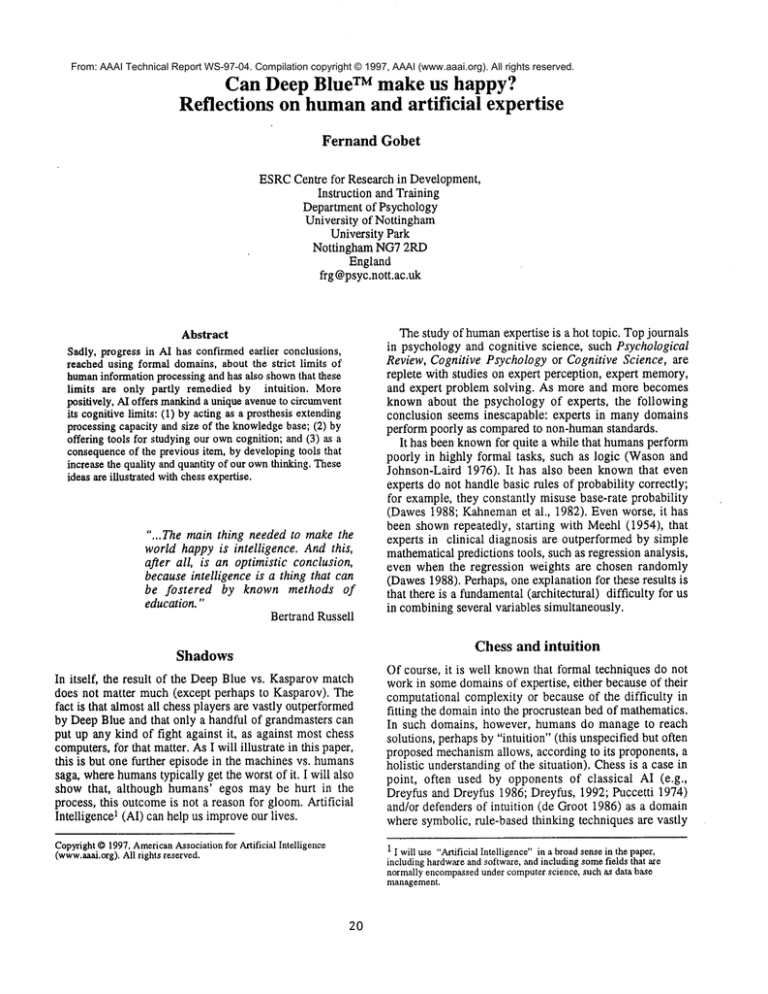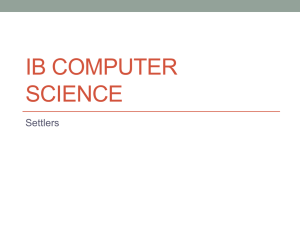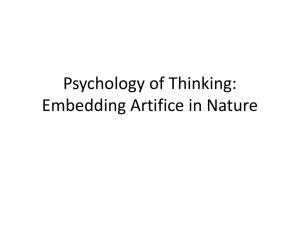
From: AAAI Technical Report WS-97-04. Compilation copyright © 1997, AAAI (www.aaai.org). All rights reserved.
Can Deep Blue TM make us happy?
Reflections on humanand artificial expertise
Fernand Gobet
ESRC
Centre for Researchin Development,
Instruction andTraining
Departmentof Psychology
University of Nottingham
UniversityPark
Nottingham NG72RD
England
frg@psyc.nott.ac.uk
Abstract
Sadly,progressin AI has confirmed
earlier conclusions,
reached
usingformaldomains,aboutthe strict limits of
human
information
processing
andhasalso shown
that these
limits are only partly remediedby intuition. More
positively,AIoffers mankind
a uniqueavenueto circumvent
its cognitive
limits: (1) byactingas a prosthesisextending
processing
capacityandsize of the knowledge
base;(2)
offeringtoolsfor studying
ourowncognition;and(3) as
consequence
of the previousitem,by developing
tools that
increasethe qualityandquantityof ourownthinking.These
ideasareillustratedwithchessexpertise.
"...The mainthing neededto makethe
worldhappyis intelligence. Andthis,
after all, is an optimistic conclusion,
becauseintelligence is a thing that can
be fostered by known methods of
education."
BertrandRussell
Thestudyof humanexpertiseis a hot topic. Topjournals
in psychologyand cognitive science, such Psychological
Review, Cognitive Psychologyor Cognitive Science, are
replete with studies on expert perception, expert memory,
and expert problem solving. As more and more becomes
knownabout the psychologyof experts, the following
conclusion seemsinescapable: experts in manydomains
performpoorly as comparedto non-human
standards.
It has beenknownfor quite a while that humansperform
poorly in highly formal tasks, such as logic (Wasonand
Johnson-Laird1976). It has also been knownthat even
expertsdo not handlebasic rules of probability correctly;
for example,they constantly misusebase-rate probability
(Dawes1988; Kahneman
et al., 1982). Evenworse, it has
been shownrepeatedly, starting with Meehl(1954), that
experts in clinical diagnosis are outperformedby simple
mathematical
predictionstools, suchas regressionanalysis,
even whenthe regression weights are chosen randomly
(Dawes1988).Perhaps,one explanationfor these results
that there is a fundamental
(architectural) difficulty for
in combining
several variables simultaneously.
Chess and intuition
Shadows
In itself, the result of the DeepBluevs. Kasparovmatch
does not matter much(except perhaps to Kasparov).The
fact is that almostall chessplayersare vastly outperformed
by DeepBlueand that only a handful of grandmasterscan
put up anykind of fight against it, as against mostchess
computers,
for that matter.AsI will illustrate in this paper,
this is but onefurther episodein the machinesvs. humans
saga, wherehumans
typically get the worstof it. I will also
showthat, although humans’egos maybe hurt in the
process, this outcome
is not a reasonfor gloom.Artificial
Intelligence1 (AI)can help us improveour lives.
Copyright
©1997,
American
Association
forArtificialIntelligence
(www.aaai.org).
Allrightsreserved.
Of course, it is well knownthat formaltechniquesdo not
workin somedomainsof expertise, either becauseof their
computationalcomplexityor becauseof the difficulty in
fitting the domaininto the procrusteanbedof mathematics.
In such domains, however, humansdo manageto reach
solutions, perhapsby"intuition" (this unspecifiedbut often
proposedmechanism
allows, accordingto its proponents,a
holistic understanding
of the situation). Chessis a case in
point, often used by opponentsof classical AI (e.g.,
Dreyfusand Dreyfus1986; Dreyfus, 1992; Puccetti 1974)
and/or defendersof intuition (de G-root1986)as a domain
wheresymbolic,rule-basedthinking techniquesare vastly
11willuse"Artificial
Intelligence"
in a broad
sense
in thepaper,
including
hardware
andsoftware,
andincluding
some
fieldsthatare
normally
encompassed
undercomputer
science,suchas database
management.
20
outperformed by humanholistic, perceptual thinking. But
how good are human solutions in these domains? To
answer this question, let us have a look at someempirical
results. Again, chess is a goodchoice, because it is one of
the most studied domainsin research on expertise.
Research has clearly established that perception plays a
key role in humanchess expertise. This is reflected in a
series of quite amazing abilities that experts have
developedin the process of reaching their level, and that
differentiate themfrom novices. For example, experts’ eye
movementsshowthat they look faster at the key elements
of a chess position (de Groot and Gobet 1996). This allows
them, as was shown by De Groot, Chase and Simon, to
remember positions much better than weaker players
(Chase and Simon 1973; de Groot 1965)--they can even
recall randompositions better, thoughnot as well as game
positions (Gobet and Simon1996a). This also allows them
to search the problem space very selectively, homing in
rapidly on the important variations and pruning many
irrelevant branches of the search tree. Empirical evidence
for the latter fact comes from rapid-transit
chess
(Calderwood et al., 1988) and from simultaneous games
(Gobet and Simon 1996b). For example, Kasparov plays
roughly at his normal strength when simultaneously
opposedto eight Masters of international level.
With progress in AI, however,things are turning sour for
the proponentsof the idea that intuition offers a satisfactory
palliative for search: computersare showingus that world
experts are not that goodeven in "preserved" domainssuch
as chess, wheremathematicaland statistical tools cannot be
applied practically. Chess grandmasters and masters are
now regularly outperformed by computers. Even worse,
comparison with endgame databases show that they play
rather poorly in endings that are considered as elementary
in textbooks. Consider the ending King-Queenvs. KingRook, which is typically dealt with in a few pages in
endgametextbooks. In a fascinating piece of research,
Jansen (1992) has shown that even world-class
grandmasters regularly make errors that makewinning the
game take on average four times longer than the optimal
line of play. Becauseof the presenceof the so-called fifty,
move rule, this means that, in manycases, they would
achieve only a draw instead of a win. (In actual play
against a human opponent, they manage to win faster
because the defending side makeserrors at about the same
rate). Interestingly, even authors of textbooks, whohave
the opportunity to movethe pieces on the board and are not
subject to time pressure, make errors that would make
winningtake about twice as long as ideally necessary.
As mentioned above, chess has often been used to
illustrate
the bankruptcy of rule-based and symbolic
thinking and the necessity of supposing a holistic modeof
perception. By contrast, the examplesjust discussed have
illustrated situations where these symbolic techniques do
better than humanintuition, and have even shown where
intuition fails. Whetherthis trend--the victory of rulebased rationality--will be confirmedin the future for other
tasks is a fascinating question. For the time being, I will
21
limit myself to addressing the question of what AI can
contribute to humancognition.
Lights
Thus, progress in AI has reinforced the conclusions
reached earlier by studies of logical and probabilistic
reasoning: our capacity for thinking correctly is limited
indeed. The humanspecies, although perhaps a bit smarter
than other species, is far from having reached a high level
of rationality. Goneis the concept that reason is the chief
qualify of our species (to quote Russell again, from Faith
and Mountains:"Wethink, it is true, but we think so badly
that I often feel it would be better if we did not.").
Interestingly, one of the main conclusions of the last 30
years of research in AI has been that it is easy to write
programsthat do better than humansin tasks that tap highlevel cognitive functions, but that it is very hard to even
approach the low-level perceptual capacities that we share
with other mammals.
Is this a reason to despair about mankind’srationality?
No, it is not. This is because AI not only showsour limits,
but also helps us to overcomethem, in several ways.
First, AI augments our processing capacity and the
extent of our knowledgebase. In chess, use of computers
has allowed us to solve endgamequestions that had been
studied for centuries, and for which quite inaccurate
conclusions had sometimes been reached. A typical
example is the celebrated endgame King-Queen-g_Pawn
vs. King-Queen,wheretheoreticians (incorrectly) proposed
that the best defense was to place the King awayfrom the
Pawn.It also allows one to use master gamedatabases to
study statistically endgamesthat are beyondthe scope of
exhaustive databases and to derive heuristics from the
statistical regularities of these endgames(Sturman, 1996;
Timoshchenko, 1993). Examples include the relative
strengths of Bishop vs. Knight. A final exampleis offered
by Alth/~fer’s
experiments showing that a human
"collaborating" with a computer produces a game that is
superior to that of the humanand the computer taken
individually(Alt/~fer, 1997).
In domainsmore pressing than chess, such as technology
and science, similar techniques, including the data mining
techniques developed within the Deep Blue technology,
makeit possible to efficiently and routinely process masses
of data the analysis of which was unthinkable twenty years
ago. As examples from computational chemistry witness,
they also allow us to search huge problem spaces rapidly
(Valdes-Perez, 1994). For manyof the problems facing
us--starvation, pollution, economicrecession--problems
that contain thousand of variables interacting in complex
ways, this extension to our thinking capability probably
offers the only hopeof finding a solution.
Second, AI offers tools for studying our owncognition.
One the one hand, AI offers us standards with which to
compareour ownperformance. There is no doubt that the
challenges offered by DeepBlue for chess and Chinookfor
checkers opened up new dimensions in the play of
Kasparovand the late Dr. Tinsley, respectively. In addition,
it is hard to over-estimate the impact of computerson the
quality of today’s play, particularly in our understandingof
endgamesand openings. Finally, Jansen (1992) has shown
howproperties of perfect-play databases (in this case, the
endgame King-Queen vs. King-Rook) can be studied
theoretically and can be manipulatedin order to carry out
experiments illuminating aspects of humancognition.
On the other hand, AI offers us the mean to construct
complex models of chess cognitive processes, as is
illustrated in earlier work by Simon(Simonand Barenfeld
1969; Simon and Gilmartin 1973) and in my own work
with CHREST
(Gobet 1993). These computational models
are only a modest illustration of the manycomputational
models, including Soar (Newell 1990) and ACT-R
(Anderson1993) that foster our understanding of cognition.
The presence of computational models and of standards
against which to compare human expertise provides
powerful tools for cognitive scientists to study our own
intelligence. It also offers the possibility of elucidating
puzzling concepts such as "intuition," which have eluded
understanding because of the lack of adequate experimental
environments. With this goal in mind, and given the
consent of the humanplayers, parameters in Deep Blue
could be varied in order to systematically study factors
underlying Grandmasters’ famedintuition. Alternatively,
Deep Blue parameters could be varied in order to study
which constellations produce play that humanexperts
woulddeem "intuitive." The conclusions reached by these
experiments could be used to implement a computational
modelof intuition.
Third, and perhaps most importantly, AI allows us to use
our increased understanding of human cognition to
improve our ownrationality, by developing software that
increases the quality and quantity of our thinking. In chess,
artificial tutors are just beginningto maketheir appearance,
offering both instructional material and on-line playing
advice. But outside chess, they are already quite common.
The best examplesof artificial tutors are perhapsoffered by
Anderson’s tutors, based on the ACT-Rtheory of human
cognition, whichhave been shownto teach skills like LISP
programmingor geometrymore effectively than traditional
methods. It is highly probable that the impact of AI on
education will be huge in the future (see Andersonet al.,
1995, for a review).
Conclusion
It is true that, as AI technologyis importedinto chess, it
also modifies the essence of this game. Chess is a highly
competitive domain in which an AI program may be seen
either as an unwelcome
competitor or as an unfair source of
help for the opponent. The presence of computers has
already caused the change of several official chess rules
and has induced a trend towards more rapid games, where
22
external help is more clearly bannedthan in traditional 3minutes-per-move games. Will AI also change the "rules
of the game"in domainssuch as warfare and the economy?
In conclusion, AI is both the bad guy and the goodguy:
it pinpoints our limits, but it also allows us to go beyond
these. As Lord Russell put it so well, intelligence mayhelp
us be happy. Had Russell lived until the present time of
blossoming AI, I’m sure that he would have said that
Artificial Intelligence will be a major contributor to the
world’ happiness.
Acknowledgments
I am grateful to Julian Pine and Frank Ritter for useful
commentson this paper.
References
AltOfer, I. (1997). A symbiosis of manand machinebeats
grandmaster Timoshchenko.ICCAJournal 20: 40-47.
Anderson, J. R. (1993). Rules of the Mind. Hillsdale, NJ:
Lawrence Erlbaum.
Anderson, J. R., Corbett, A. T., Koedinger, K. R., &
Pelletier, R. (1995). Cognitive tutors: Lessons learned.
The Journal of the Learning Sciences 4:167-207.
Calderwood, B., Klein, G. A., & Crandall, B. W. (1988).
Time pressure, skill, and move quality in chess.
American Journal of Psychology 101:481-493.
Chase, W. G., & Simon, H. A. (1973). Perception in chess.
Cognitive Psychology4:55-81.
Dawes, R. M. (1988). Rational choice in an uncertain
world. Orlando, FL: Harcourt Brace Jovanovich.
de G-root, A. D. (1965). Thought and choice in chess. The
Hague: MoutonPublishers.
de Groot, A. D. (1986). Intuition in chess. ICCAJournal
9:67-75.
de Groot, A. D., & Gobet, F. (1996). Perception and
memoryin chess. Heuristics of the professional eye.
Assen: Van Gorcum.
Dreyfus, H. (1992). What computers still can’t do. A
critique of artificial reason. Cambridge,MA:The MIT
Press.
Dreyfus, H., & Dreyfus, S. (1986). Mind over machine.
NewYork: Free Press.
Gobet, F. (1993). Les m~moiresd’un joueur d’dchecs [The
memoriesof a chess player]. Fribourg (Switzerland):
Editions Universitaires.
Gobet, F., & Simon, H. A. (1996a). Recall of rapidly
presented randomchess positions is a function of skill.
PsychonomicBulletin & Review 3:159-163.
Gobet, F., & Simon, H. A. (1996b). The roles
recognition processes and look-ahead search in timeconstrained expert problem solving: Evidence from
grandmasterlevel chess. Psychological Science 7:52-55.
Jansen, P. J. (1992). Using knowledgeabout the opponent
in game-tree search. Ph.D. diss. CMU-CS-92-192,
Dept.
of ComputerScience, Carnegie Mellon, Pittsburgh.
Kahneman,D., Slovic, P., & Tversky, A. (Eds.). (1982).
Judgments under uncertainty: Heuristics and biases.
Cambridge, England: CambridgeUniversity Press.
Meehl,P. E. (1954). Clinical versus statistical prediction:
A theoretical analysis and a review of the evidence.
Minneapolis: University of MinneapolisPress.
Newell, A. (1990). Unified theories of cognition.
Cambridge, MA:Harvard University Press.
Puccetti, R. (1974). Pattern recognition in computers and
the humanbrain: Withspecial reference to chess playing
machines. British Journal for the Philosophy of Science
25:137-154.
Simon, H. A., & Barenfeld, M. (1969). Information
processing analysis of perceptual processes in problem
solving. Psychological Review 7:473-483.
Simon, H. A., &Gilmartin, K. J. (1973). A simulation
memoryfor chess positions. Cognitive Psychology 5:2946.
23
Sturman, M. (1996). Beware of the bishop pair. ICCA
Journal 19:83-93.
Timoshchenko, G. (1993). Bishop or Knight? ICCA
Journal 16:209-216.
Valdes-Perez, R. E. (1994). Conjecturing hidden entities
via simplicity and conservation laws: Machinediscovery
in chemistry. Artificial Intelligence 65:247-280.
Wason,P. C., & Johnson-Laird, P. N. (1976). Psychology
of reasoning. Structure and content. London:Batsford.




